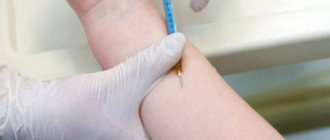Indications
In the Russian Federation, the Mantoux test is performed once a year on children from 12 months until adulthood. Some children are given tuberculin twice a year; indications for testing more often may include:
- lack of vaccination against tuberculosis;
- contact with a patient with tuberculosis;
- dubious Mantoux results;
- the presence of chronic diseases that increase the risk of contracting tuberculosis;
- living in a social risk group.
The Mantoux test is often performed to diagnose the disease. If a child develops symptoms of tuberculosis or if the results of a routine Mantoux test are suspicious, an additional test is done.
The main purpose of the test is to recognize tuberculosis in the initial stages in children and adolescents. Adults can also undergo this procedure, but for people over 18 years of age, fluorography and sputum analysis are more informative.
Questions and answers related to the Mantoux test
Modern parents want to know everything. They storm the Internet in search of answers to a variety of questions, including medical ones. One of the popular topics is the Mantoux test. You can hear different things about it: they say that Mantoux is not 100% effective, that tuberculin contains life-threatening phenol and can generally infect a child with tuberculosis, and that a Mantoux test is not necessary now. It is difficult for a non-specialist to understand the flow of specific information. And, seeing this concern from parents, we decided to try to answer most of the most frequently asked questions about the Mantoux test.
How dangerous is the Mantoux test?
The Mantoux test is the main method for detecting tuberculosis in children. This is not a vaccination, but a diagnostic test for the presence of tubercle bacilli in the child’s body (a study of the strength of immunity to the tuberculosis pathogen by assessing the reaction to a special drug - tuberculin). Mantoux is an intradermal test; it contains neither living nor dead tuberculosis bacilli. It is harmless both for healthy children and for persons with various somatic diseases. The presence of a pronounced skin reaction indicates the presence of intense immunity, that is, that the body is actively interacting with the pathogen. The Mantoux test is a kind of immunological test that shows whether there is a tuberculosis infection in the body.
They say that tuberculin contains phenol.
Sometimes parents do not want to perform the Mantoux test on their children, citing the fact that tuberculin contains phenol. But our body is no stranger to phenol. It is formed independently in our intestines and tissues. 160 mg of phenol is formed in the body per day - this is 640 times more than in one mantoux sample. Phenol is also found in cheese, fish, chicken, tobacco smoke and tea. Phenol is released from resins covering furniture and from some synthetic fabrics.
Some parents are trying to replace the Mantoux test with an annual x-ray...
These are two completely different types of examination of a child. The Mantoux test makes it possible to determine whether a child is infected with a tuberculosis bacillus, and an x-ray shows whether the child has contracted tuberculosis or reveals other various pathologies of the lungs.
Some parents worry: “The child will be registered and we will be kicked out of kindergarten, or they will not treat us like that at school”...
If the child is registered, it’s okay. Such children attend kindergarten and school. They are not tuberculosis patients, do not secrete the tuberculosis bacillus, and are not dangerous to their family or others. Children are observed, examined, treated and gradually removed from the register. This usually happens within a year or two, depending on the diagnosis. Nobody is afraid of these kids.
But they also say that the test is given to everyone, even sick children. Are there any contraindications to the Mantoux test?
There are contraindications. Mostly temporary. If a child has pneumonia, pleurisy, or bronchopneumonia, the doctor gives a medical exemption for 2 months. The same period for infectious diseases (measles, rubella, chickenpox). After bronchitis you need to wait 1–1.5 months. Do not perform the Mantoux test during exacerbations of skin and allergic diseases, etc. It should be remembered that the result of the reaction may be influenced by a recent infection. The Mantoux test after an acute infection is performed a month (at least 3 weeks) after the disease. However, do not despair, such an influence of past infections on the test results is extremely individual and depends on the nature and severity of the disease suffered, as well as on the properties of the immune system of each individual child. In some cases, the disease may not affect the sample. But in the future you should remember this. And since Mantoux tests are usually warned in advance, you, knowing that your child has recently been sick, will have to warn your class teacher or school nurse about this.
Are there any children who should not be given it at all?
The Mantoux test is not harmful to the body of a healthy child or a child with chronic somatic pathology (heart disease, lung disease, digestive disease). Tuberculin does not contain Mycobacterium tuberculosis, and the dosages in which it is administered into the skin have no effect on the immune system or the body as a whole. However, the test is prohibited for children under one year old, since the result will be distorted or inaccurate, which depends on the age-related characteristics of the immune system - reactions can be false or negative. In addition, there are a number of contraindications for performing the Mantoux reaction at any age (they were already mentioned just above): skin diseases at the injection site, exacerbations of chronic diseases, then Mantoux is done a month after remission, acute infections, allergic diseases in the acute stage, epilepsy attacks, quarantine for childhood infections.
How can a child become infected with tuberculosis? What if the family is good and we don’t have contact with tuberculosis patients?
It should be remembered that children, especially teenagers, have much less developed immunity than adults. Immunity is sharply reduced in children who often suffer from colds. There are common areas and public transport. But today, not everyone is tested for tuberculosis, and many buy fake certificates to enter work or study without undergoing fluorography. Therefore, many people get sick without noticing minor symptoms, ride in public transport, walk down the street and even work as teachers and nannies in kindergartens and schools. Many tuberculosis dispensaries are not closed; patients can travel in public transport and lead an active lifestyle. This is how infection occurs not only in adults, but also in children and adolescents.
We forgot about Manta and wet it, now the result is not correct? How to properly care for her?
You can wet the Mantoux sample. This is an intradermal test, so water cannot get into the skin. If you follow the logic of soaking, then water, on the contrary, should wash out the antigen and make the test less pronounced. The belief that water should not be allowed to enter the site of the tuberculin test dates back to the times when, instead of the Mantoux test, the Pirquet test was performed, which was carried out by scratching the skin through drops of tuberculin, and accordingly there was an open wound at the site of the test. A wet site where the tuberculin test is performed can provoke itching, mainly in children suffering from allergic diseases, so the only thing that is recommended is not to rub the site of the Mantoux test with brushes and washcloths, and for children with a history of allergies, the test should be carried out against the background of antihistamine therapy, and also limit chocolate, etc. allergens. There is no need to care for the sample in any way. If the pen gets wet while swimming, blot the injection site with a dry soft cloth, and do not cover the injection site with a band-aid, smear it with peroxide or brilliant green.
What should a “button” look like?
After the test is performed on days 2-3, a specific skin thickening is formed - the so-called. “papule” (infiltrate, compaction). In appearance, it is a slightly raised rounded area of skin above the skin. When you press lightly on it with a transparent ruler (or if you press and release with your finger), it should turn slightly white. Unlike simple redness, to the touch (although this cannot always be detected with your fingers), the papule differs from the surrounding skin in its consistency - it is denser. From an anatomical point of view, this papule is the result of a kind of saturation of the skin with cells, namely lymphocytes, sensitized (that is, sensitive) to Koch's bacillus. Naturally, the more lymphocytes in the body that “know” about mycobacteria (and they can learn about mycobacteria either after BCG vaccination or after direct infection), the larger the infiltrate (papule) will be. Only the seal size is measured. Redness around the lump is not a sign of immunity to tuberculosis or infection, but it is recorded when there is no papule.
And how to estimate the size of this very papule?
Everything is simple here. With a negative reaction, there is no complete infiltrate or at the injection site there is only an injection site of 1-2 mm, the reaction will be doubtful with a papule of 2-4 mm or redness of any size without infiltration, a positive reaction occurs with a papule of 5 mm, and the average intensity is 5 –9 mm, intense reaction is 10–14 mm, pronounced reaction is more than 15 mm. A hyperergic reaction is diagnosed when the infiltrate is more than 17 mm in children and more than 21 mm in adults, as well as in the presence of vesicles or a zone of necrosis in the test area, and the presence of a reaction of the lymph nodes.
How often should a Mantoux test be performed?
In accordance with the Order of the Ministry of Health of the Russian Federation in Russia, the Mantoux test is performed once a year, starting at the age of 12 months, regardless of the results of the previous test. Performing a Mantoux test more often than once a year is not advisable. In doubtful cases, the Mantoux test is usually repeated after 6 months. In every doubtful case, when it comes to repeating the Mantoux test in a shorter period of time, only a specialist, a phthisiatrician, has the right to prescribe these unscheduled tests and stipulate the timing of their implementation... and nothing more.
We were given a “tuberculin test turn” on our card - what is it?
The turn of the Mantoux test is an increase in the size of the button in comparison with the previous year and previously identified results. This is a very valuable diagnostic sign that has certain criteria for evaluation:
- For the first time, a positive Mantoux of more than 5 mm in diameter appeared, when previously there were negative ones.
- the previous reaction differs from the current one by 6 mm or more,
- reaction more than 17 mm,
- reaction of more than 12 mm 4 years after vaccination against tuberculosis.
It is the variation of the sample that usually speaks in favor of infection during the last year of life. In this case, it is necessary to exclude allergic reactions, defects in the execution of the test, or a combination of the test with vaccinations. You must also remember about the special, “booster” effect of the test - when it is carried out frequently, more than once a year, it can give a very strong reaction.
We have a positive Mantoux test - is the baby really sick?
The Mantoux test shows not only infection with Mycobacterium tuberculosis, but also reflects the degree of immunity tension during BCG vaccination. To determine whether it is an infection or immunity from a vaccination, the doctor will take into account the size of the scar on the shoulder after the vaccination; it is usually given in the maternity hospital. In addition, the age of the baby, the results of previous Mantoux tests and the size of the papule today are taken into account. They look for a scar on the left shoulder, it is usually from 2 to 10 mm, the larger the scar, the more active the immune system, usually how many millimeters, how many years. If there is no scar, this indicates a lack of immunity to the vaccine; under this condition, a positive Mantoux is more likely to speak in favor of infection. With a normal scar, the reaction in the first 2 years should be positive, and in subsequent years it will gradually fade away; by about 6–7 years, Mantoux should become negative. At the age of seven, such children receive a second BCG booster vaccination in order to strengthen their immunity. If, after a gradual reduction in the size of the Mantoux, a bend appears, most likely an infection has occurred and then you will need to consult a phthisiatrician and decide on the issue of chemoprophylaxis.
- Author - Polukhina Anastasia Aleksandrovna
- 15.03.2015
- All consultations by the author
Contraindications
This diagnostic method is not used in the following cases:
- presence of immunodeficiency;
- in case of a severe allergic reaction with consequences from a previous test or the presence of such reactions in close relatives;
- the presence of fermentopathy;
- serious disruption of the central nervous system;
- bronchial asthma;
- epilepsy.
Infectious diseases or skin rashes are contraindications for which the test is postponed for a while; a test can be prescribed 2-3 weeks after the illness. In case of quarantine in a child care facility, the test is carried out after it is lifted. A break of at least a month is required between any vaccination and the Mantoux test, since vaccines can affect the test results.
What should you not do before the procedure?
It is important for parents to know what not to do before performing Mantoux on a child. This will help prevent unwanted consequences.
Prohibited:
- visit crowded places, especially during an epidemic (kindergarten, shopping and entertainment centers, fairs);
- get vaccinated a few days before the Mantoux test;
- add allergenic foods to the diet;
- go on long trips with your baby;
- take immunomodulatory medications;
- Give the child antihistamines if he is not allergic. This may distort the result.
If you ignore the advice of doctors on preparation, this can result in the following negative consequences:
- temperature rise to 39-40 degrees;
- deterioration or loss of appetite;
- the appearance of dizziness;
- the occurrence of vomiting, constipation, diarrhea;
- development of disturbances in the functioning of the lymphatic system;
- the appearance of skin rashes and itching.
In addition to the tuberculin test, there are other ways to detect Koch's bacillus in the body. If the Mantoux test result is distorted, then the child may be prescribed a diaskintest. This diagnostic method accurately records the fact of tuberculosis infection.
Algorithm of actions
To carry out the tuberculin test, special syringes with a beveled cut on the needle are used; they are called tuberculin syringes. They must be new. To carry out the test, the following algorithm of actions is performed:
- The ampoule with tuberculin is opened.
- 0.2 ml of tuberculin is drawn into the sample syringe, and the patency of the needle is checked. According to the instructions, the syringe should not expire; the nurse must check it before the procedure.
- The sample area is treated with cotton wool and alcohol.
- The needle section is inserted subcutaneously; it should be directed upward, the syringe should be almost parallel to the arm.
- When tuberculin is injected, a small papule forms on the arm.
If this procedure is followed, the results will be accurate.
Every year the hand for the test is changed, in even years it is the right hand, in odd years it is the left hand. This sequence is used to obtain reliable results, since when using the same hand, the papule increases every year.
Results are assessed after 3 days. During this period, the papule should not be treated with antiseptics, rubbed with a washcloth or combed, as these actions can affect the results. You can wet Mantu, but the rule about prohibition is a misconception. Unlike the subcutaneous Pirquet test, the ingress of water does not in any way affect the result of the Mantoux test. After trying restrictions on physical activity - no.
Evaluation of results
The results of the study are checked three days after the test; it is after this period that the immune response to tuberculin is maximum. The results are monitored by a nurse or doctor using a transparent ruler. It is important to measure the papule, and not the redness around it; the results of the study are determined by its size.
A result is considered negative when there is no papule at the site of tuberculin injection, and slight redness is possible. A negative result may occur in people who have not been vaccinated with BCG or in children and adults who have been vaccinated for more than five years.
The absence of a reaction to tuberculin indicates that the person is healthy and does not have tuberculosis bacteria.
If the BCG vaccination was done less than 5 years ago, and the reaction is negative, then the body has not produced the necessary antibodies.
Also, if a person has been suffering from tuberculosis for a long time, the body may not react when tuberculin is administered, then the result is called a false negative. Therefore, this technique is not used to monitor the healing process.
The test result is called doubtful if the size of the papule is from 2 to 4 mm, positive - more than 5 mm. Evaluation of the results should take into account the dynamics of the sample size over recent years and the duration of BCG vaccination.
For persons who have been vaccinated against tuberculosis, a result of up to 10 mm is considered normal and indicates the presence of antibodies to the bacteria that cause tuberculosis. Additional studies may be required if there is a hyperergic reaction to the test (over 17 mm) or if the result increases by more than 6 mm compared to the previous year.
The brown color of the papules and the presence of pustules may indicate that a person is infected with tuberculosis.
Tuberculin test: is it necessary to do?
Many parents who have not yet thought about what is safer for the child, Mantoux or X-ray, mistakenly take the test for a vaccination against tuberculosis, but the situation is different. During the Mantoux test, the child is injected with waste products of Koch's bacillus, the causative agent of tuberculosis, in a weakened form. Then, over the course of several days, the body’s immune system’s response to the invasion of the tuberculosis pathogen is assessed. An absent or insignificant reaction indicates that the child is not infected with tuberculosis. Therefore, in reality, a tuberculin test is not necessary if another diagnostic method has been chosen.
Possible reactions
Since tuberculin is an allergen, it can cause various allergic reactions. The sample also contains phenol; it is a toxic substance, but safe in small doses; if you are intolerant to phenol, an allergic reaction is also possible. If parents or siblings have had a severe allergic reaction to a tuberculin test, it is better to use other diagnostic methods.
The most common reaction is itching at the injection site. Scratching should be avoided. It is also rare for a reaction to occur in the form of an increase in temperature.
Despite possible reactions, the Mantoux test is one of the safe and accessible technologies for diagnosing tuberculosis in children and adolescents. In the absence of contraindications, its implementation is mandatory.
How to prepare a child for the Mantoux test?
Preparation for Mantoux in children begins a few days before diagnosis. It needs to be approached very responsibly. It is necessary to adhere to a number of simple rules.
Pediatricians give the following advice to parents on preparing their child for a tuberculin test:
- avoid contact with sick people infected with a virus or infection;
- strictly observe the rules of personal hygiene;
- organize the correct diet and food consumption regimen. Nutrition should be balanced and light;
- protect the child from physical and psycho-emotional fatigue. It is better to avoid visiting sports sections and swimming pools for a few days before the Mantoux test. It is important to maintain a sleep-wake schedule.
Overwork and poor nutrition weaken the body and can cause a false positive reaction or complications of the test. Before doing the Mantoux test, you need to make sure that the child is healthy. To do this, you should be examined by a pediatrician. If there is any doubt that the immune system has not fully recovered after a past illness, then the doctor will issue a referral for blood and urine tests.
If there are chronic pathologies of internal organs, the doctor recommends that the child undergo an ultrasound and other hardware diagnostic procedures. The fact is that Mantoux creates a certain load on the body. This can lead to negative symptoms.
Tuberculin diagnosis is contraindicated in the following pathological conditions:
- infectious viral diseases;
- epilepsy;
- cold;
- skin diseases in the acute phase at the site of the tuberculin test;
- atopic dermatitis;
- presence of allergies;
- bronchial asthma;
- exacerbation of chronic pathologies;
- rheumatism;
- disturbances in the functioning of the digestive system;
- state of immunodeficiency.
To go to the clinic for the test, it is recommended to prepare clothes in advance. It is advisable that things be made from natural, lint-free fabric (cotton, silk). Clothes should be clean, ironed, and loose. You should dress appropriately for the weather: it is important that the child does not get cold or sweat.
It is necessary that the child be calm and well-fed during the procedure and feel normal. If the baby experiences weakness or general malaise on the day of the procedure, it is better to reschedule the test.









